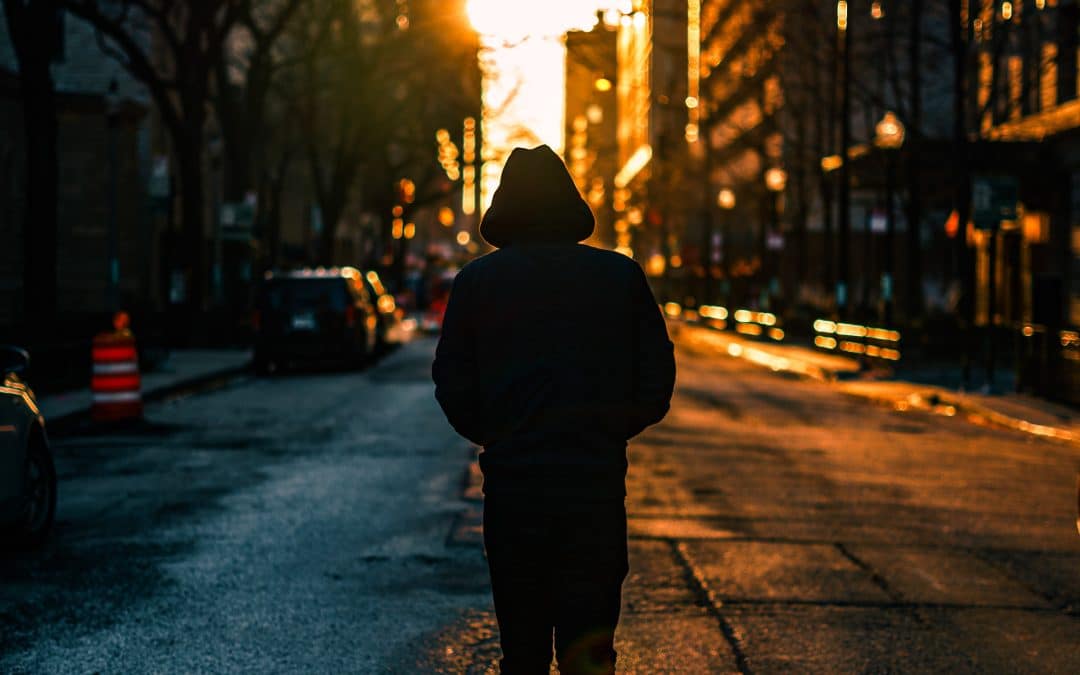
by Jennifer Wolkin | May 4, 2020 | Mindfulness, Stress, Wellness
I am writing to you at this unprecedented time in our history. A time of collective, global trauma. We’re scared. We’re vulnerable. We’re mentally exhausted. People are saying to stay positive, but I want to validate your emotions, you are safe from the catchphrase ‘good vibes only’ here.
There is so much beyond our control these days. As humans, we don’t like uncertainty at the best of times, at baseline. We thrive on timelines and surefire deadlines. So we are all trying our best to find equanimity, mental calmness, amidst this uncertainty.
It is my hope that these 17 #StayCovidCalm actionable tips, that you can take today, will help you focus on treating yourself with kindness during this difficult time. You don’t have to have a productive pandemic, just take care of yourself to the best of your abilities, and that’s more than enough.
Set media/news boundaries:
Be very discerning of the media you are consuming (stick to known reliable sources), and set boundaries around when and how you consume media. I’d recommend not to watch it right before sleep, and to set specific times during the day to read or watch and have a cut-off time.
- It won’t help to check news every 15 minutes. This won’t lead to any more productive action, and will only serve to induce panic. Keep yourself updated with ONLY important, helpful facts from well-informed sites. Saturating on social media can literally overwhelm our brains.
- It’s also very reasonable to set boundaries with people who are sending you information. If someone is texting you with information every hour, and it’s creating anxiety, do gently let that person know that this isn’t serving you. Take appropriate action.
- Keep prepared, because it is the mindful thing to do for oneself and society at large. This means do what is recommended with as little worry as possible that you’re not doing enough. If you’re doing what’s recommended, then you are doing enough.
Allow yourself to feel all the feels:
It is not only okay, but a necessity to allow ourselves to experience the gamut of emotions we encounter, and not just try to stay positive and feel “good vibes only,” which sometimes is a message we confront on social media. Allowing ourselves to feel all we are feeling, without shame or judgment, and then seeing that we can move through these emotions, is essential for mental health right now. Our mind space is big enough for all the feels, even seemingly contradictory ones. In fact, allowing space for them is healthy. I call this “feelings the ands”, as in, “I feel this AND this.”
Practice gratitude:
while it is important to allow yourself to have all the feels, it can ALSO help to take a moment to consciously express gratitude at least once each day and to take perspective. So, before you go to sleep, or after waking up, see if you can list and reflect upon three things in that very moment you feel grateful for and, if needed, you can use the same three each time. Examples include: loved ones, health, healthcare providers, leadership during this time, roof over one’s head, groceries, grocery shop personnel, the sun coming out, a breeze, the warming weather.
Create structure and routine as much as possible:
At baseline our brain’s like a sense of routine, it helps maintain perceived control, and our brain veers towards “order”, especially during a time of great uncertainty. Of all times, this is a time to build in some kind of routine to your day. This could mean going to sleep and waking up at the same time. This could mean doing virtual work in the same space every day. This could even look like a scheduled afternoon walk, as long as we are abiding by social distancing.
Virtually connect:
Social connection is paramount during this time. Even if it’s not your ideal to connect virtually, give yourself a healthy push to reach out to be in touch with and be held by a community. Even if we don’t love it, we must push ourselves to connect with others – social connection is key and crucial, even virtually. It may not be ideal but it is something that will keep you safe and healthy.
Find creative outlets:
Creative expression connects us back to ourselves. It also allows us to use our mind in ways that promote a sense of freedom in a time when we are feeling locked down.
Journal:
Record history from your first-person perspective if this will help you create a sense of purpose. During so much unknown, having a call to action that creates a sense of meaning can go a really long way towards lifting depressed feelings.
Pray:
Reach out to whatever you believe is out there that is greater than you. This allows us to surrender some of the burden that we might feel to have all the answers, and the need to problem solve and fix what is beyond our power to do so.
Connect to something greater/give back:
Asking how can I be of service often helps us get outside our own selves and can soften depression and anxiety. It gives us a sense of purpose, to create meaning at a time when not much seems to make sense.
Focus on what we can control vs. what we can’t:
There is so much we can’t control now, and also, at the same time, we have been given guidelines to adhere to. If we allow ourselves to follow what’s recommended, and surrender into the knowing that we can’t control much more, we might feel some anxiety relief.
Practice radical acceptance:
Practice radically accepting the present-moment for what it is. This doesn’t mean we roll over and passively resign to whatever circumstances we are experiencing. What it means is totally and completely accepting that the reality of this moment, is, in fact, the reality of this moment, and that to resist present-moment reality is not only impossible, but creates stress. Radical acceptance is a practice based on the idea that although we can’t control for the most part how life unfolds, we can, in fact, control how we perceive or react to life unfolding. Fighting against reality, even if said reality is painful, is likely to cause suffering beyond that of the reality itself.
Exercise:
Both weight training and cardio have mental health benefits. This can mean jumping jacks or jogging in place, or using weights you have at home while following along to a YouTube guided workout. Many gyms are also doing virtual sessions. Weight training exercise is a life force and a crucial part of mind-body-brain hygiene. Exercise has been shown to raise serotonin levels, the neurotransmitter that many antidepressants focus on producing. Exercise can also elicit endogenous endorphins, the body’s natural painkillers, and of course, bring more oxygenated blood to the brain.
Stretch:
Just as crucial as exercise is, so is stretching regularly, to ease tension and stiffness, especially if we are sitting more while in quarantine. Particularly, try to make time to stretch my psoas muscles. They are the only muscles that connect the spine to the legs, attaching from the 12th thoracic vertebra to the 5th lumbar vertebra through the pelvis and down to the femurs. Needless to say, the psoas muscles, therefore, play a crucial role in one’s core structural wellness, especially the psoas major, the biggest muscle of the group.
- The absolutely mind-blowing understanding regarding the psoas muscles though, is that they have been actually touted as instrumental to one’s mental well-being as well! The psoas muscles flank the diaphragm and the many connections between the psoas muscles and the diaphragm literally link these muscles to our breath, which is sensitive to fear. When we are in a state of fear, the breath is shallow and constricted, and the diaphragm isn’t being used to take deeper, calming breaths. The psoas feels this, and holds the fear. This means that if we are in a constant fight or flight mode, due to chronic stress, then our psoas muscles are also chronically stressed and constricted. This would also mean that an over-constricted psoas, caused by poor posture for example, could actually elicit fear.
- So, after hours and hours of sitting in a position that constricts our psoas muscles, it’s no wonder we have a visceral feeling of tension that seems to envelop our minds, bodies, and brains. Stretching my psoas is literally like a sigh of relief. There are videos online to help guide in how to find the psoas and how to stretch it with the most significant impact.
Maintain physical wellness:
Mental health and medical health are inextricably intertwined.
- Eat regular meals: Try to eat set meals to nourish yourself. If you tend to overeat during a stressful time, see if you can take a step back, and self-soothe with other more adaptive techniques like breathwork, or distracting with a conversation with a friend. If you do eat more than you want, don’t judge yourself. This is an ongoing practice.
- Limit caffeine: If you tend to panic, watch your coffee intake. Stick to one cup a day or less.
- Support your immune system through diet: Of course, ask your general practitioner, certified health coach, nutritionist or functional medicine doctor before you make any changes to your regimen. Generally speaking, I suggest whole grains, high protein, berries, leafy greens, including spinach and kale.
- Decrease processed sugar: Processed sugar is highly inflammatory, and does not support immunity, and can also lead to mental health challenges.
- Supplements: I defer to your general practitioner here too, however, generally speaking Vitamin C, D3, and Zinc has been suggested to boost immunity. Turmeric and ginger can also play an anti-inflammatory role.
Maintain mental health care:
Maintain all regimens you were usually doing for mental health. Sometimes in crisis we let things slide, but please continue your psycho-pharmacology regimen if you have one. If you have a therapist, connect virtually. If you don’t have a therapist, you can still find one during this time, many are taking new patients even virtually. Psychologytoday.com has a search engine for therapists in your area. Also, talkspace.com and betterhelp.com are great options.
Be gentle, be gentle, be gentle:
I listed a lot of things. But ABOVE all, be gentle with yourself. Find adaptive ways to cope, and also, if you are just able to get by and breathe and do the best you can, it’s okay. There is no end to the beginnings we can take. In any moment, we can try to engage in these coping skills, and if the next moments they seem harder, we can try again in another.
Practice mindfulness and mindful living:
Whether we use an app to help guide us through a mindfulness practice, engage in deep diaphragmatic breathing, incorporate mindfulness into any daily activity, or living more mindfully, this is a way to 1. Sit with uncomfortable emotions without needing to escape them 2. Offer oneself gentleness, compassion, and nonjudgment 3. Elicit the relaxation response.
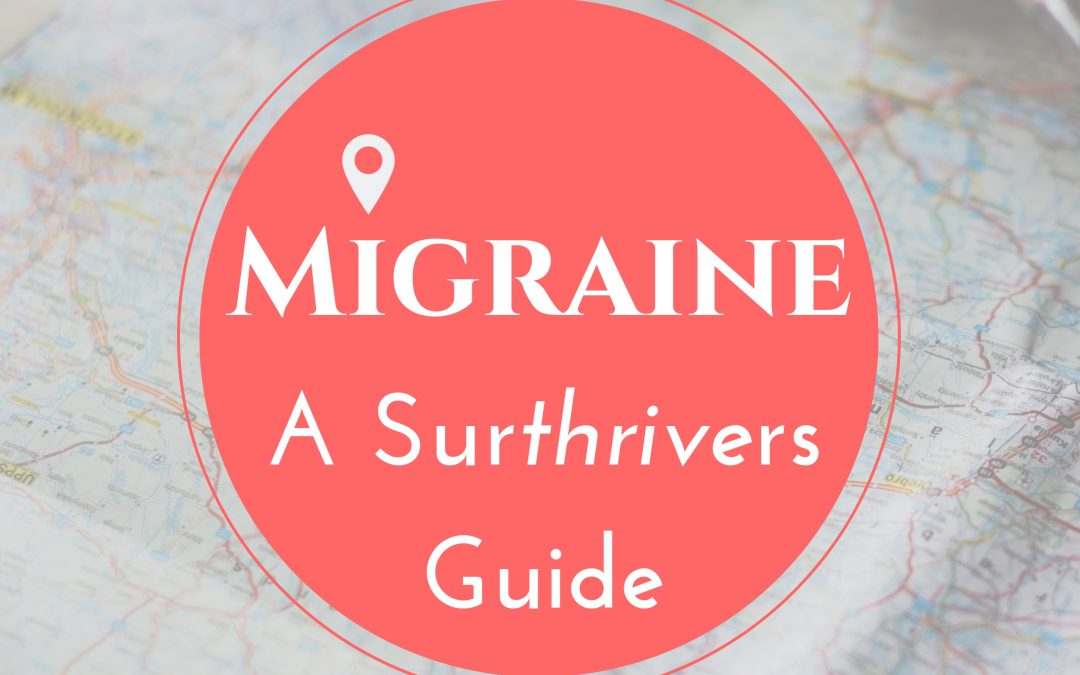
by Jennifer Wolkin | Jun 4, 2019 | Brain Health, Stress, Wellness
During Acute Migraine Attack:
During an acute attack, I am in immediate relief mode. In addition to abortive medicines prescribed by my neurologist, my go-to is heat on my back and neck, to relax the clenching that ensues. My migraine often starts in the neck, then up through the jaw – so if I can loosen those muscles ASAP I have some chance of preventing a more severe version of migraine.
Microwavable Heat Pad: Body

CLICK TO BUY
Microwavable Heat Pad: Neck

CLICK TO BUY
I also use ice if I am feeling pain, either directly on the pain point, or on my full face. This helps dull the pain, and also, quite frankly, distracts me.
In addition, research has found that cooling our vagus nerve (which runs from the brain to our abdomen via connections in our face and neck) helps to stimulate a parasympathetic response – which is our relaxation response. This is in direct opposition to the fight or flight sympathetic response that is usually stimulated at the onset of discomfort.
A more relaxed self can help desensitize a brain in pain.
Gel Bead Cold Eye Mask
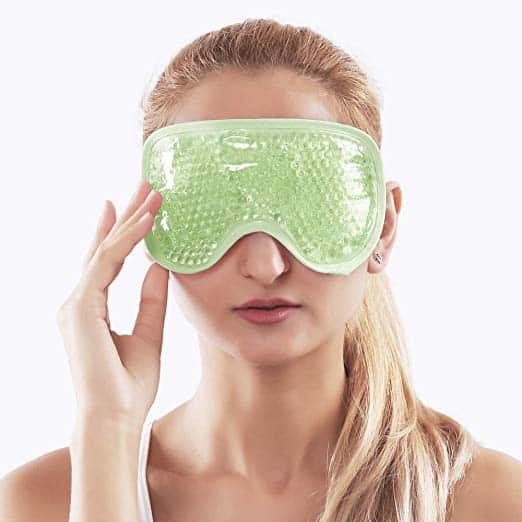
CLICK TO BUY
Full Face Gel Bead Mask 
CLICK TO BUY
Another tried and true hack for me is immediately placing a small drop of peppermint oil on my wrists, and then sometimes on my temples (making sure it’s not too close to my eyes). I’ll then pull my wrists toward my nose and inhale and exhale slowly.
Peppermint Essential Oil

CLICK TO BUY
I also get extremely nauseous during acute attacks, so I make sure to stock my fridge with my favorite ginger ale, and I sip on that as needed. I like this kind, because it isn’t full of high fructose corn syrup, and other additives!
Boylan’s Ginger Ale

CLICK TO BUY
Overall Migraine Wellness:
While stress doesn’t cause migraine, research indicates that stress is one of the more infamous triggers of a migraine. A trigger is a factor or an event that can contribute to the onset of a migraine. These vary from person to person, and it’s often a combination of multiple triggers that sets off a migraine attack.
What’s interesting and relevant is that the chronic everyday life stressors, like work and relationships, are the cause of most headaches – as opposed to big episodic stressful experiences or events. This means that even when I am not acutely experiencing migraine, keeping stress levels at bay is one way to help stave off migraine. Other factors, like barometric pressure, and hormonal imbalances are out of my control. I can do my best, however, to keep up the stress-relief.
While I’m not an MD, I have included the Magnesium and Riboflavin supplements that have been recommended to me by physicians and fellow migraine sur-thrivers.
IMPORTANT NOTE: Before trying any supplement, clear it with your migraine specialist first.
KAL Magnesium Glycinate 400

CLICK TO BUY
Vitamin B2 400mg (RiboFlavin)
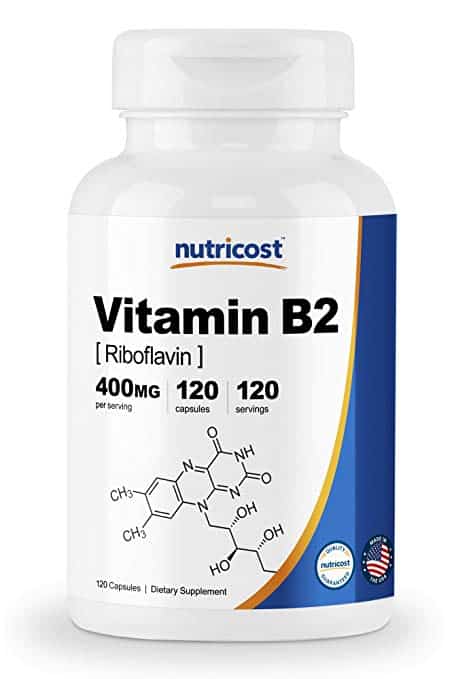
CLICK TO BUY
For me personally, before bed, I like to drink Vata tea.
Organic Calming Vata Tea

CLICK TO BUY
Ginger Root Tea

CLICK TO BUY
Whenever I have the opportunity, I soak in a bath of Epsom salts so that at baseline my muscles are less tight and clenched.
Epsom Salt

CLICK TO BUY
Epsom Salt with Lavender
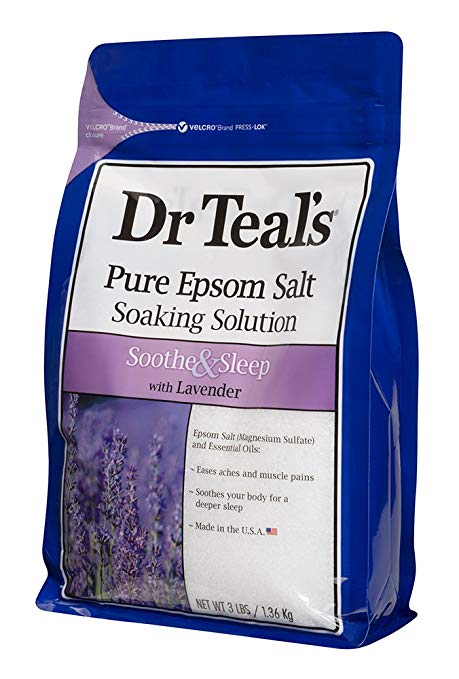
CLICK TO BUY
I also make sure use a sleep-mask to ensure proper sleep hygiene. Getting enough sleep is a huge component to my overall migraine self-care.
Sleeping Mask

CLICK TO BUY
What migraine hacks have you found that work for you?
I’d love to hear from you, let’s heal together! Email me at DrJen@BrainCurves.com or add your comment below.


by Jennifer Wolkin | Jul 5, 2018 | Blog, Brain Health, Mindfulness, PTSD, Wellness
On the evening of March 26th, 2012, Yvonne Kent Pateras suffered a massive hemorrhagic stroke, leaving her unable to speak or move. She also experienced “locked-in” syndrome. These are Yvonne’s own words regarding the traumatic stroke she experienced:

“I had the experience of knowing what was happening to me from the beginning. I felt a sinus rhythm in my head becoming louder. I tried to center myself, but it was over before I had time to act. I opened my mouth to shout for help-the noise that left my body was the most primordial noise. My beautiful voice had been replaced by the noise of a wounded beast. I wouldn’t hear another word for the next for 3 months. I knew that I had not only suffered a stroke, I was paralyzed and locked in. I couldn’t tell my family that I knew what was going on. I tried to just keep my neurons busy and alive. I did simple counting exercises to stay calm and occupied-to keep my adrenaline levels under control. I was determined to survive.”
After four months in the hospital, to everyone’s surprise, and with extraordinary courage, Yvonne was able to regain speech and movement. Yet, in a span of approximately ten months, she suffered three ischemic strokes, and another hemorrhagic one. Since different kinds of strokes require different treatments, medical care was challenging.
Yvonne persevered. She said that recovery required “endless effort.” She can now walk without difficulty. She has a light speech impediment and lost some functioning in her right hand.
As we now know, with post-traumatic growth, trauma like this can often serve as a catalyst for a profound awakening to an emotional and spiritual transformation. Yvonne’s awaking came in the form of writing poetry.

“Following the stroke I went through a spell of re-learning, like being born again. Feelings were overpowering my mind’s concentration and understanding. Writing verses were facilitating the expression of my feelings. Publishing my work also gave me upmost satisfaction, particularly as the response by other stroke victims was so moving. Poetry takes the weight off my legs, gives me wings!!!”
You can find Yvonne’s poetry in her book, Stroke Journeys, by clicking on this link.
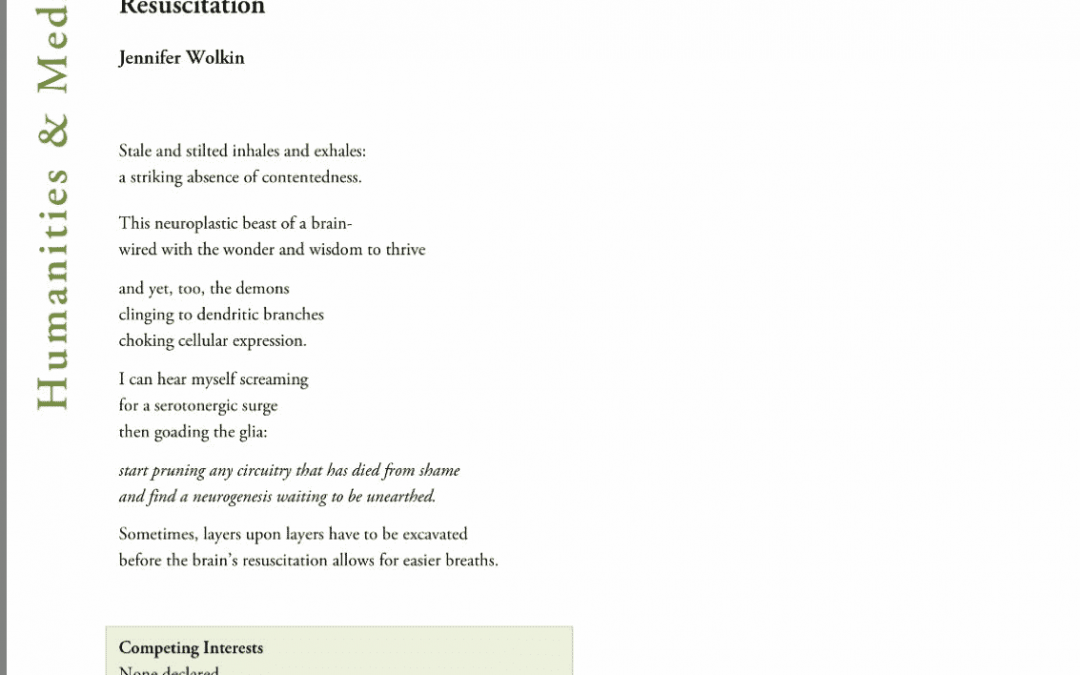
by Jennifer Wolkin | Jul 4, 2018 | Blog, Mindfulness, PTSD, Wellness
There is research that those experiencing PTSD reported improved well-being in response to poetry therapy. This might be the case because a hallmark of having experienced trauma is the subsequent difficulty processing the experience, which results in avoiding and suppressing associated emotions/memories.
Poetry therapy has provided an outlet for those suffering with PTSD to start to integrate many of these feelings, and even more so, to start to reframe the traumatic experience.
Poetry therapy itself is a bit abstract to describe, but there are a few ways to engage with it. Here is a multi-model poetry therapy practice developed by Nicholas Mazza, the founding and continuing editor of the Journal of Poetry Therapy.
According to Mazza’s model, poetry therapy involves three main components:
- Receptive/prescriptive: This part of therapy involves the clinician/therapist reading a poem out loud, and then subsequently encouraging the client to react to it, either verbally, non-verbally, or both. The therapist might even prompt: “Is there a particular line in the poem that resonated with you?”, or “I noticed you started to become teary-eyed when I read this line…”
- Expressive/creative: This entails actual creative writing. The therapist promotes stream of consciousness writing that might aid in discovering blocked emotions, parsing felt emotions, or retrieving memories that are difficult to articulate. The therapist might offer a prompt to help someone get started.
- Symbolic/ceremonial: This includes working with metaphor/simile to help further explain emotions that are hard to describe in a more literal sense. The ceremonial part may consist of writing a letter to someone they may have lost and then burning it.
The efficacy of poetry therapy is still being studied. Most of the empirical evidence for its effectiveness comes through James Pennebaker’s (a pioneer in the field of Positive Psychology) work in the therapeutic use of expressive writing. His studies have indicated that the use of expressive writing, even for as little as 15 minutes over the course of 4 days, resulted in positive health effects. In addition, his initial work dealt with the use of expressive writing to heal wounds from traumatic stressful events.
One case in point is that in the aftermath of 9/11, poetry was utilized as a healing mechanism. According to a New York Times article on October 1, 2001:
“In the weeks since the terrorist attacks, people have been consoling themselves—and one another—with poetry in an almost unprecedented way … Improvised memorials often conceived around poems sprang up all over the city, in store windows, at bus stops, in Washington Square Park, Brooklyn Heights, and elsewhere. …”
In some ways poetry gives us the way to speak about the unspeakable. It is more and more common for those suffering with medical challenges to write their story, many times in poetic form, to aid in their own healing. As always, it is crucial to note that just like with mindfulness approaches to trauma, poetry therapy is most often used in conjunction with other therapies.
On a personal note, I’m particularly drawn to this type of therapy and recently started studying for my MFA at Queens College. I am touched by the profound pain that is both individually and collectively felt, how this pain can displace someone from others and their selves, and yet, the profound capacity for resilience, healing, and growth. Aside from writing my own work, I hope to employ poetry as a technique to help my clients say what they couldn’t otherwise say.
Here’s an example of a poem that I recently published in the British Journal of Medical Practice in this vein:

by Jennifer Wolkin | Jul 3, 2018 | Blog, PTSD
By way of full-disclosure, I’m tearing up as I write this. In the last few years alone, we have seen a rise in mass school shootings; that is, the death of innocent children, adolescents, and their adult mentors/teachers in cold blood.
I too, continue to grapple with the snuffing out of so many lives, and the lack of response to these deaths that somehow don’t seem to create change. Actually, most school shootings aren’t even talked about.
According to a non-profit that tracks gun violence in America, as of April 20th 2018, there have been 17 shootings since the February shooting at the Marjory Stoneman Douglas High School in Parkland, Florida which launched the Never Again movement. You read that number correctly.
I don’t want to get too political here, but as a mental health practitioner and staunch advocate, I want to go on record saying that gun violence is not a mental health issue. Is mental health sometimes a component in these shootings? Sure. Yet, let’s be clear. The rise of school shootings is not attributable to a national mental health crisis. It is far too easy for someone to get a gun in this country. No matter which side of the gun control debate you are on, it is insulting with those who suffer with mental health to be accountable for this.
Here’s some info taken straight from MentalHealth.gov to keep in mind:
Myth: People with mental health problems are violent and unpredictable.
Fact: The vast majority of people with mental health problems are no more likely to be violent than anyone else. Most people with mental illness are not violent and only 3%–5% of violent acts can be attributed to individuals living with a serious mental illness.
Now that I made that clear, I want to discuss PTSD in the context of these shootings.
Undoubtedly, these shootings will impact the victim’s families, friends and communities forever – some might even develop PTSD, as they are certainly at risk, especially those who survived and witnessed the events.
Of course, what we have seen come out of the Parkland shooting is no less than a post-traumatic growth response (learn more in my PTSD packet); while this doesn’t mean the survivors aren’t deeply suffering, many have been able to utilize this suffering as fuel to advocate for gun control in a way it seems that no other organization or group of individuals has been able to before. Their efforts have affected real change, and I pray the change continues.
What I want to address is the idea of virtual trauma. We, as a nation, are privy to these events either in real time, or moments after. Sometimes, the media coverage is more gruesome and detailed than at others. Regardless, we, as a nation, are at risk for PTSD even if we were not directly affected. Whether we were involved or not, these accounts bring up a real sense of danger and deep concern about our and our loved one’s safety.
According to research in the early 2000’s, approximately 15 to 36 percent of the population that did not experience violence directly, will still develop post-traumatic stress disorder (PTSD) symptoms.
The impact of trauma has a wide range. Even just hearing about the event can shatter our assumptions about our world. You see, tragedies like these reverberate in the hearts and minds of much of humanity, as it rips through the basic foundation that we lay our trust upon. That is, we don’t expect people to just shoot other human beings in cold blood. So, it seems that trauma’s effect surpasses the psycho-neurobiological impact of experiencing a direct threat to one’s own life.
According to psychologist Janoff-Bullman, what a mass trauma like this does is challenge our assumptions and brings them into question.
These assumptions may include:
- “the world and people are intrinsically good”
- “good people experience good things”
- “the world is safe”
- “the world is just”
Undoubtedly, these assumptions aren’t necessarily true, but can be healthy and adaptive. For many of us, these very assumptions help us get out of bed in the morning and actually go about our lives and are necessary for meaningful experiences and interpersonal relationships.
The figurative ground we walk on becomes shakier and shakier with each shooting. If you notice that after an event you start feeling more irritable, anxious, like you have lost control, depressed, have trouble sleeping and anything else that is not your baseline and does not seem to be going away, please reach out for help.




















